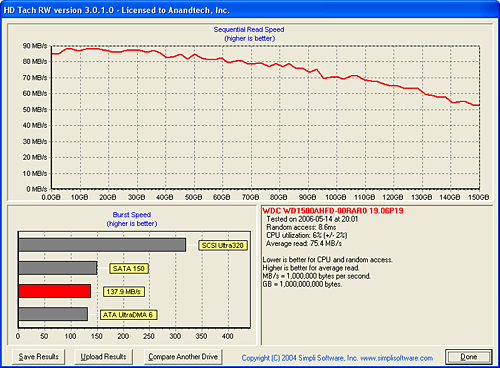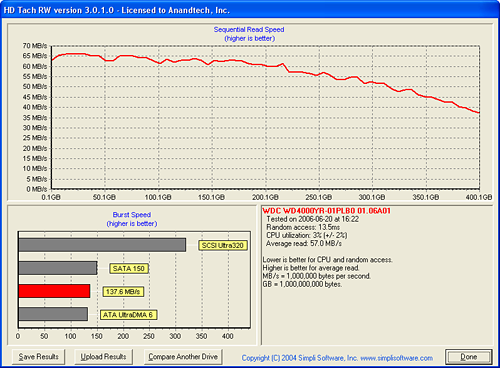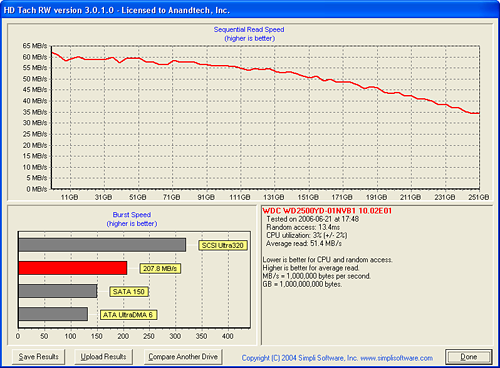Western Digital WD2500YD: Enterprise on the Desktop
by Gary Key on June 24, 2006 10:00 AM EST- Posted in
- Storage
Features
The Western Digital WD2500YD 250GB drive we are reviewing today will be compared against the leading RE2 Western Digital drives along with the drive that has redefined performance in the Serial ATA market, the WD1500 Raptor. We have also included the results of the Seagate 7200.10 750GB and 7200.09 500GB drives from our previous article. As a side note, the manufacturer and operating system drive capacities reported are different due to the calculation utilized by each party to arrive at the drive's stated capacity. There is not an actual difference in the drive's size after the operating system formats the drive.
While the Seagate drives are not in the same market sector as the RE/RE2 based drives, we thought it would be interesting to see how other desktop centric drives would perform in our testing. We will be comparing our RE16/RE2 drives to the recently released Seagate NL35.2 and Maxtor MaXLine Pro drives in the near future with an emphasis on nearline enterprise storage capabilities. We will provide additional reviews in the coming weeks for the desktop centric drives in both the 500GB and 250GB~320GB capacity ranges.
HDTach Performance:




We find HD Tach to be useful for generating random access and average transfer rate results in a very consistent manner. Although the burst rates and CPU utilization numbers appear interesting, they tend to be meaningless in actual application performance comparisons.
The Raptor has the highest average sequential read speed of 75.4 MB/s with the RE2 500GB drive at 62.4 MB/s, RE2 400GB drive at 57.0 MB/s, and the RE16 250GB drive at 51.4 MB/s. The WD 500GB and 400GB drives score about 40 MB/s at the end of the disk with the 250GB drive at 35 MB/s. In contrast, the WD Raptor finishes with a 52 MB/s result that is more than 30% greater than the 7200 RPM drives. However, if you look at the read performance for the first 150GB on the 7200 RPM drives, all three manage higher than or equal to the minimum transfer rates of the Raptor.
The random access time benchmark favors the 10,000RPM spindle speed of the Raptor which generates a result of 8.6ms. The 7200RPM drives results are close with the nod going to the 500GB and 250GB drives at 13.4ms while the 400GB drive finishes at 13.5ms. The average rotational latency at 10,000 RPM is 3ms while the average rotational latency at 7200 RPM is 4.17ms; what this means is that the head seek speed on the Raptor is significantly faster (~5.6ms) than the other drives (9.2-10.0ms). Although the WD2500YD has very good burst rates we will soon see this does not always translate into class leading performance.
| Hard Drive Specifications | ||||
| Western Digital Raptor WD1500AHFD | Western Digital RE2 WD5000YS | Western Digital RE2 WD4000YR | Western Digital RE WD2500YD | |
| Manufacturer's Stated Capacity | 150GB | 500GB | 400GB | 250GB |
| Operating System Stated Capacity | 139.7GB | 465.8GB | 372.6GB | 233.7GB |
| Interface | SATA 1.5Gb/s | SATA 3Gb/s | SATA 1.5Gb/s | SATA 3Gb/s |
| Rotational Speed | 10,000 RPM | 7,200 RPM | 7,200 RPM | 7,200 RPM |
| Cache Size | 16 MB | 16 MB | 16 MB | 16 MB |
| Average Latency | 2.99 ms (nominal) | 4.20 ms (nominal) | 4.20 ms (nominal) | 4.20 ms (nominal) |
| Read Seek Time | 4.5 ms | 8.7 ms | 8.7 ms | 8.9 ms |
| Number of Heads | 4 | 8 | 8 | 4 |
| Number of Platters | 2 | 4 | 4 | 2 |
| Power Draw Idle / Load | 9.2W / 10.0W | 8.9W / 10.8W | 8.9W / 10.8W | 8.7W / 9.5W |
| Command Queuing | Native Command Queuing | Native Command Queuing | Native Command Queuing | Not Applicable |
| Warranty | 5 Years | 5 Years | 5 Years | 5 Years |
The Western Digital WD2500YD 250GB drive we are reviewing today will be compared against the leading RE2 Western Digital drives along with the drive that has redefined performance in the Serial ATA market, the WD1500 Raptor. We have also included the results of the Seagate 7200.10 750GB and 7200.09 500GB drives from our previous article. As a side note, the manufacturer and operating system drive capacities reported are different due to the calculation utilized by each party to arrive at the drive's stated capacity. There is not an actual difference in the drive's size after the operating system formats the drive.
While the Seagate drives are not in the same market sector as the RE/RE2 based drives, we thought it would be interesting to see how other desktop centric drives would perform in our testing. We will be comparing our RE16/RE2 drives to the recently released Seagate NL35.2 and Maxtor MaXLine Pro drives in the near future with an emphasis on nearline enterprise storage capabilities. We will provide additional reviews in the coming weeks for the desktop centric drives in both the 500GB and 250GB~320GB capacity ranges.
HDTach Performance:




We find HD Tach to be useful for generating random access and average transfer rate results in a very consistent manner. Although the burst rates and CPU utilization numbers appear interesting, they tend to be meaningless in actual application performance comparisons.
The Raptor has the highest average sequential read speed of 75.4 MB/s with the RE2 500GB drive at 62.4 MB/s, RE2 400GB drive at 57.0 MB/s, and the RE16 250GB drive at 51.4 MB/s. The WD 500GB and 400GB drives score about 40 MB/s at the end of the disk with the 250GB drive at 35 MB/s. In contrast, the WD Raptor finishes with a 52 MB/s result that is more than 30% greater than the 7200 RPM drives. However, if you look at the read performance for the first 150GB on the 7200 RPM drives, all three manage higher than or equal to the minimum transfer rates of the Raptor.
The random access time benchmark favors the 10,000RPM spindle speed of the Raptor which generates a result of 8.6ms. The 7200RPM drives results are close with the nod going to the 500GB and 250GB drives at 13.4ms while the 400GB drive finishes at 13.5ms. The average rotational latency at 10,000 RPM is 3ms while the average rotational latency at 7200 RPM is 4.17ms; what this means is that the head seek speed on the Raptor is significantly faster (~5.6ms) than the other drives (9.2-10.0ms). Although the WD2500YD has very good burst rates we will soon see this does not always translate into class leading performance.










11 Comments
View All Comments
driveguy - Monday, June 26, 2006 - link
I do not understand why the YD family was reviewed so late in it's life.The YS familily has been introduced from 160-500GB on a common platform.
It would make much more sense to review the current product.
Gary Key - Monday, June 26, 2006 - link
We reviewed the recent product life update to the YD family that changed it to the RE16 family with 16MB cache and 3GB/s SATA support. The YS family (160GB~320GB range) just started shipping in volume earlier this month and samples are arriving shortly in the 160GB and 250GB sizes. We received the 320GB YS today that will be tested against the other 320GB drives from Western Digital and Seagate in the near future. Thank you for the comments.
driveguy - Tuesday, June 27, 2006 - link
Hi Gary,Thank you for your response.
YS goes from 160GB to 500GB. The real attraction for the RE products is reliability more than performance. This is really not something you can review because you will not have access to field failure rates but these drives have done quite well in high duty cycle envirements. They have crushed STX NL models in the market with the absolute lion's share of this market.
Gary Key - Wednesday, June 28, 2006 - link
Hi,I could have been a little clearer in my 160GB~320GB statement, my point was those drive sizes just started shipping in volume this month. The 400GB and 500GB drives were shipping in May although we have not received the 400GB sample yet. I think with the YS series WD has brought the nearline performance up to and at times exceeding the SE16 line now. I think it will be interesting comparing the NL35.2 to the WD YS series since both are new product releases. We are implementing a 16 drive RAID chassis for enterprise/benchmark testing shortly so we should be able to look at some failure rate information this time next year in this market segment.
Thanks...
Squidward - Monday, June 26, 2006 - link
By looking at this article and others I've seen the Raptor is hands down the best drive you can get without going into SCSI drives. How does that apply to real usage, is the difference that notable versus the other drives in this article? I've been considering buying one if the difference is truly noticable, particularly as it applies to game loading times and recording tv programs.tallman45 - Saturday, June 24, 2006 - link
Nice job as always with the review.A more valuable comparison IMHO though would have been like cost competitors such as the new 74GB 16mb cache Raptor and the 7200.10 320gb Seagate. It stands to reason that a $300 150GB Raptor had better outperform a $90 250gb YD
Gary Key - Saturday, June 24, 2006 - link
Hi,We have the new 74GB 16MB cache Raptor arriving in about 10 days. We have completed our testing on the Seagate 320GB 7200.10 and are in the process of completing several other 200GB~320GB drives for a desktop roundup shortly in what we believe is the best price to performance range at this time. Our 500GB roundup and PVR article will be available in late July. As stated in the article we will also do a separate review on RAID performance with both nearline enterprise and desktop drives in the near future. The process of adding additional multi-tasking benchmarks along with doing both hardware (Areca) RAID and soft (nF500) RAID is painstakingly slow. ;->
The other process we have setup is an additional test bench that is currently running previously reviewed drives 24/7 with varying stress tests so we can start reporting on reliability and doing a quick follow-up on the drives performance every few months. In about two weeks, you should start seeing storage articles from us about every 10 days.
Thank you for the comments.
Gary Key - Saturday, June 24, 2006 - link
Where is the edit button? :) I meant to end my reply with "storage reviews from us about every 10 days or less."dhei - Saturday, June 24, 2006 - link
150gig raptor is around $200 now...dhei - Saturday, June 24, 2006 - link
forgot to add the 75gig Raptor is only $130. In terms of pure performance most people would go for the little premium in price for Raptor than more hd space. They just get a 200+gig drive for backup and install main apps on raptor.